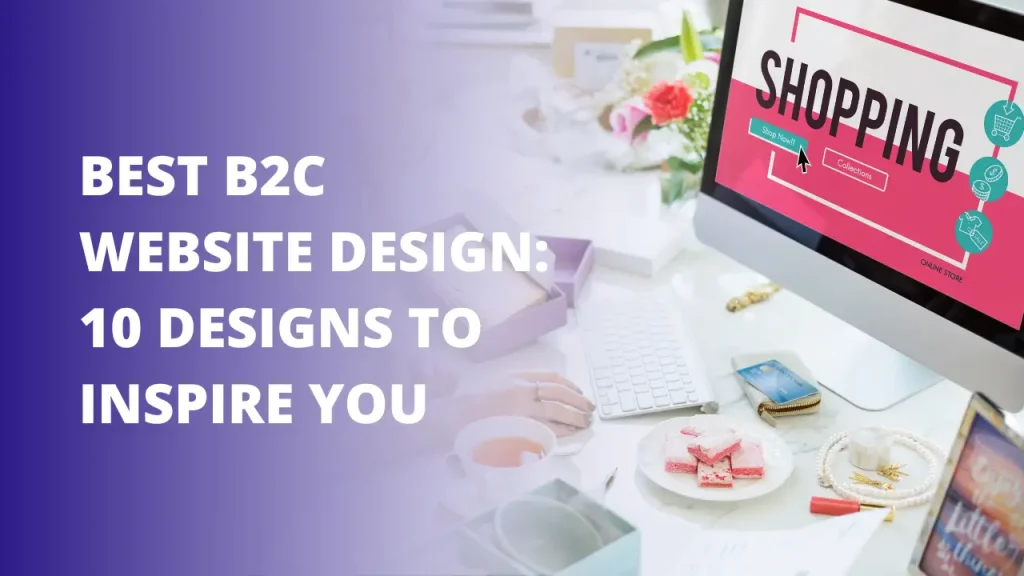In the digital age, having a well-designed B2C (Business-to-Consumer) website is important for any business looking to thrive online. In many cases, your website’s design is the first impression potential customers have of your brand, so a great design will engage visitors, improve the user experience, and ultimately boost the sales of your brand. We have been working with B2C and B2B companies for more than 10 years at Codevelop. To inspire you and to point out the key elements that make this B2C website design succeed, we’ve compiled a list of the 10 best B2C website designs. So lets get started!
Understanding B2C Website Design
Definition of B2C Websites
B2C websites are online platforms where businesses sell products or services directly to consumers. Unlike B2B (Business-to-Business) websites, which cater to other businesses, B2C sites focus on individual customers and their needs.
Key Elements of Successful B2C Websites
A successful B2C website goes beyond aesthetics. It combines functionality, usability, and engaging content to create an excellent user experience. Essential features include a user-friendly interface, mobile responsiveness, fast loading speed, high-quality visuals, and clear call-to-action (CTA) elements.
Essential Features of a Great B2C Website
User-Friendly Interface
A user-friendly interface ensures that visitors can easily navigate your website and find what they need without frustration. This includes intuitive menus, clear categories, and a straightforward checkout process.
Mobile Responsiveness
With the majority of users accessing websites via mobile devices, having a mobile-responsive design is non-negotiable. Your website should adapt seamlessly to different screen sizes and provide an optimal viewing experience on smartphones and tablets.
Fast Loading Speed
In the fast-paced digital world, a slow website can drive visitors away. Ensuring your website loads quickly improves user experience and can positively impact your search engine rankings.
High-Quality Visuals
High-quality images and videos are essential for showcasing your products effectively. Visual content should be clear, engaging, and representative of your brand’s identity.
Clear Call-to-Action (CTA)
A clear and compelling CTA guides visitors towards taking desired actions, whether it’s making a purchase, signing up for a newsletter, or contacting your business. Effective CTAs are concise, visible, and actionable.
Design Inspiration #1: Apple
Apple’s website is a paragon of sleek and minimalist design. The focus is on high-quality product images and a seamless user experience. Navigation is straightforward, and the design emphasizes elegance and simplicity, making it easy for users to find and purchase products.
Design Inspiration #2: Amazon
Amazon’s website design is geared towards comprehensive product listings and ease of use. Features like user reviews, ratings, and a robust search function help customers make informed decisions. The site is designed for easy navigation, even with its vast array of products.
Design Inspiration #3: Nike
Nike’s website stands out with bold, dynamic visuals and interactive elements. The design reflects the brand’s strong identity and emphasizes an engaging user experience. Customization options and immersive storytelling are key aspects of Nike’s site.
Design Inspiration #4: ASOS
ASOS is known for its fashion-forward design and easy search functionality. The website is user-centric, with features like personalized recommendations and a streamlined checkout process, enhancing the overall shopping experience.
Design Inspiration #5: Zara
Zara’s website features an elegant and clean layout with high-quality imagery that showcases their products effectively. Intuitive navigation and a focus on aesthetics create a luxurious online shopping experience.
Design Inspiration #6: Warby Parker
Warby Parker’s website excels in providing an engaging user experience with features like a virtual try-on tool. The design tells a story and connects with users on a personal level, enhancing brand loyalty and customer satisfaction.
Design Inspiration #7: Tesla
Tesla’s website uses futuristic design elements that reflect the brand’s innovative spirit. The emphasis is on a seamless user interface, with features that highlight the cutting-edge technology of Tesla’s products.
Design Inspiration #8: Glossier
Glossier’s minimalist aesthetic and community-driven content set it apart. The website’s simple navigation and emphasis on user-generated content create a relatable and trustworthy brand image.
Design Inspiration #9: IKEA
IKEA’s website focuses on functional design and usability. It offers inspiration and ideas for home furnishing, with easy-to-use product configurators that enhance the shopping experience.
Design Inspiration #10: Spotify
Spotify’s website provides a personalized user experience with dynamic and engaging visuals. Seamless integration with apps and a focus on user interaction make it a standout in the digital music space.
Implementing Best Practices in Your B2C Website
Analyzing Your Target Audience
Understanding your target audience is the first step in creating a successful B2C website. Analyze their preferences, behaviors, and needs to tailor your website design accordingly.
Prioritizing User Experience
User experience should be at the forefront of your design strategy. Ensure your website is easy to navigate, visually appealing, and provides value to your visitors.
Regular Updates and Testing
Regularly updating your website and testing its functionality can help you stay ahead of the competition. Monitor user feedback and make necessary adjustments to improve the overall experience.
Conclusion
In conclusion, a well-designed B2C website is essential for attracting and retaining customers. By drawing inspiration from some of the best designs out there, you can create a site that is not only visually appealing but also highly functional and user-friendly. Remember, the key to success is to keep innovating and focusing on your customers’ needs.
With over 10 years of experience at Codevelop, we understand the nuances of creating impactful B2C websites that convert visitors into loyal customers. Schedule your free consultation to discover how we can help elevate your online presence and drive your business success.
FAQs
What makes a B2C website effective?
An effective B2C website combines aesthetics, functionality, and user experience. Key elements include a user-friendly interface, mobile responsiveness, fast loading speed, high-quality visuals, and clear CTAs.
How often should I update my website design?
It’s a good practice to review and update your website design regularly, at least once a year, to ensure it stays current with design trends and technological advancements.
What tools can help with website design?
There are several tools available for website design, including WordPress, Shopify, Wix, Adobe XD, and Figma. These tools offer various features to help you create a professional and functional website.
How important is mobile responsiveness?
Mobile responsiveness is crucial as a significant portion of web traffic comes from mobile devices. A responsive design ensures a seamless experience across all devices, improving user satisfaction and SEO rankings.
Can good design improve sales?
Yes, a well-designed website can significantly improve sales by enhancing user experience, building trust, and making it easier for customers to find and purchase products.


